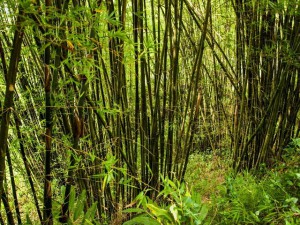 Bamboo and rattan are powerful ‘strategic forest resources’ that can bring jobs and income to millions of people in rural areas, create new income streams for communities and reverse land degradation and deforestation. But today progress toward this widespread growth is slow. It is caused by a lack of coordination between bamboo and rattan experts and agencies, technical knowledge that is difficult to access and the need for new evidence that countries can use to harness these resources to boost economic growth.
Bamboo and rattan are powerful ‘strategic forest resources’ that can bring jobs and income to millions of people in rural areas, create new income streams for communities and reverse land degradation and deforestation. But today progress toward this widespread growth is slow. It is caused by a lack of coordination between bamboo and rattan experts and agencies, technical knowledge that is difficult to access and the need for new evidence that countries can use to harness these resources to boost economic growth.
Global Assessment of Bamboo & Rattan (GABAR) – an initiative that was launched at the World Forestry Congress 2015 held, September 7-11 at Durban, South Africa will help improve this situation. GABAR is a partnership between INBAR and its 41 Member States with a range of national and international partners. The initiative is planned as a $100 million programme.
GABAR brings together some 41 bamboo and rattan resource countries, research partners, development agencies and technical specialists. It will provide rapid access to knowledge such as forest management practices, examples of bamboo and rattan value chains and business cases, studies and natural resource assessments, and input to policy issues. These are issues countries must address to create a favourable investment climate to develop these sectors.
The ability to tap the full economic and environmental potential of bamboo and rattan eludes many countries today, says Hans Friederich, Director General of INBAR, the International Network for Bamboo and Rattan. GABAR helps close this gap this by providing easy access to knowledge, practical tools and policy guidance for countries and development programmes.
“A wealth of information exists today on how to use bamboo and rattan for economic development. But it is difficult to find, and it resides in different research centers, organisations, government agencies, and with experts worldwide. At the same time there are areas where we need more research and hard evidence, such as: how much bamboo and rattan exits in the world and where is it located; what are the species, their agroecological characteristics, water and nutrient requirements and options for propagation and creation of new bamboo plantations,” he explains.
Speaking for INBAR Member States, representative of Jamaica, the INBAR Council Chair, Hon. Sharon Ffolkes Abrahams, Minister of State for Industry, Investment and Commerce of Jamaica, comments that GABAR will help bamboo and rattan resource countries be more productive. “GABAR provides them with new knowledge as well as ‘technology and policy packages’ to help strengthen their bamboo and rattan sectors. GABAR products and services will include research and synthesis activities, capacity building and the south-south exchange of technical expertise. It will also be a knowledge platform that provides information and data about bamboo and rattan that policy makers and development professionals can use to craft national strategies and actions plans.”
These plants offer dozens of new and innovative uses for income generation and improving environmental management. We need to better understand how to make the best use of them, says Friederich. “GABAR is the first global initiative of its kind that brings together practical solutions from around the world to help countries take practical steps to develop bamboo and rattan.”
